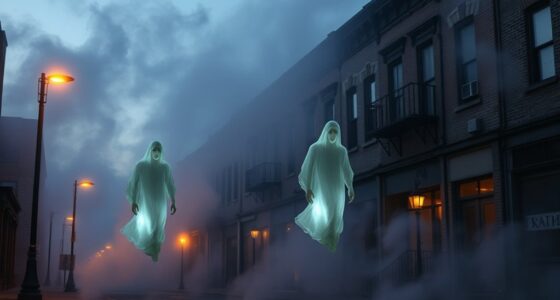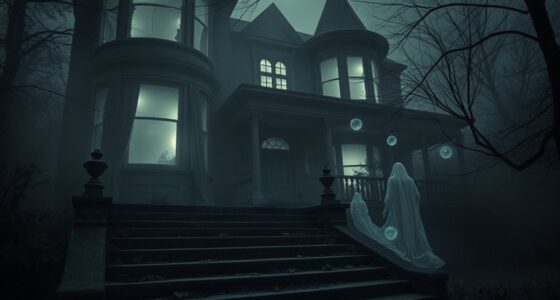Apparition classifications depend on cultural, psychological, and contextual factors that influence how you perceive and interpret sightings. They can be seen as divine messages, spirits, or just hallucinations, depending on your beliefs and surroundings. Witness credibility often hinges on the situation, witnesses, and evidence. Psychological factors like stress or trauma shape what you might believe you saw. If you keep exploring, you’ll discover how these perspectives shape what we consider genuine or supernatural.
Key Takeaways
- Apparitions are classified based on cultural, historical, and contextual factors influencing their perception and acceptance.
- Credibility increases with multiple witnesses, controlled environments, and supporting evidence.
- Psychological explanations like hallucinations or stress often account for spontaneous sightings.
- Cultural narratives shape how sightings are interpreted, categorized, and validated within societies.
- Apparition classifications range from supernatural phenomena to psychological or neurological occurrences.

Have you ever wondered why some apparitions are considered more credible than others? It often boils down to how they’re classified and the context behind their appearances. Apparitions, or ghostly sightings, aren’t all viewed equally—some are dismissed as mere tricks of the mind, while others are taken seriously by witnesses and investigators. To understand why, you need to look at the historical context and the psychological explanations that surround these phenomena. Throughout history, societies have interpreted apparitions through their cultural lens, attributing sightings to spirits, divine messages, or supernatural forces. These historical contexts shape how people perceive and validate these experiences. For example, in medieval times, visions of saints or angels were often seen as divine revelations, whereas in modern settings, apparitions might be explained through psychological factors.
Apparition credibility depends on cultural context, psychological state, and how sightings are classified throughout history.
Psychological explanations play a significant role in how apparitions are classified. Many researchers believe that what people interpret as ghostly encounters could be the result of mental processes like hallucinations, sleep paralysis, or the brain’s tendency to seek patterns and assign meaning to ambiguous stimuli. If you’ve ever experienced a fleeting shadow or heard unexplained noises, your mind might fill in the gaps with familiar images or sounds—sometimes resembling apparitions. These psychological factors can be influenced by stress, grief, or trauma, making certain individuals more prone to seeing or believing in apparitions.
Additionally, the credibility of an apparition often depends on the context of the sighting, such as whether it occurs in a controlled environment or is supported by multiple witnesses. When it comes to classification, some apparitions are considered more credible because they occur under specific conditions—such as in controlled environments or with corroborating witnesses. For instance, sightings at famous haunted locations or during investigative sessions tend to be scrutinized more carefully, often leading to a higher perception of credibility. Conversely, spontaneous sightings in everyday life might be dismissed or regarded with skepticism, especially if they lack supporting evidence. The credibility also depends on whether the apparition fits within the cultural and historical framework of the witness, as well as on the psychological state of the observer at the time.
Ultimately, your perception of an apparition’s credibility hinges on how it’s framed within these contexts. The historical narratives you’re familiar with influence your interpretation, while your psychological state can determine whether you see a meaningful figure or simply a product of your mind. By understanding these classifications—rooted in history and psychology—you gain a clearer perspective on why some apparitions are accepted as genuine and others are dismissed as illusions or hallucinations.
Frequently Asked Questions
How Do Apparitions Differ Across Cultures Worldwide?
You’ll notice apparitions differ across cultures through their cultural symbolism and ritual practices. In some societies, spirits appear as ancestors, guiding and protecting, while in others, they symbolize warning or misfortune. Ritual practices like ceremonies or offerings often shape how these apparitions are perceived and interacted with. These differences reflect unique beliefs and histories, making each cultural experience with apparitions distinctive and meaningful within its spiritual context.
Can Apparitions Be Scientifically Validated or Proven?
Did you know that only about 5% of reported apparitions have been scientifically validated? You might wonder if apparitions can be proven, but currently, empirical evidence remains limited. Scientific skepticism prevails because most sightings lack verifiable proof, making it hard to confirm their reality. While some claims are intriguing, rigorous testing and reproducible results are necessary before you can accept apparitions as scientifically proven phenomena.
What Psychological Factors Influence the Perception of Apparitions?
Psychological factors like suggestibility and emotional trauma heavily influence how you perceive apparitions. If you’re highly suggestible, you’re more likely to interpret ambiguous stimuli as ghostly figures, especially in stressful or emotional situations. Trauma can also trigger vivid hallucinations or perceptions that feel real, making you more prone to experiencing apparitions. Your mental state and past experiences shape what you see, hear, or feel during these encounters.
Are Certain Individuals More Prone to Experiencing Apparitions?
Yes, you’re more prone to experiencing apparitions if you have certain psychological predispositions or are dealing with personal grief. Your mind’s sensitivity to emotional stress and unresolved feelings can make you more likely to perceive or interpret ambiguous stimuli as apparitions. These factors heighten your expectations or fears, leading you to experience visions or encounters that reflect your emotional state, especially during times of loss or intense personal hardship.
How Do Historical Accounts of Apparitions Vary Between Periods?
Historical accounts of apparitions vary wildly across periods, and it’s like comparing night and day. You’ll find that during certain eras, reports were exaggerated or based on limited understanding, while in others, they were carefully documented. Factors like historical context and reporting accuracy shape these accounts, making some seem almost mythical. The way people described apparitions shifts with cultural beliefs, technology, and societal norms, creating a fascinating tapestry of evolving perceptions over time.
Conclusion
Now that you know the nuances of apparition classifications, you can confidently confront curious cases and clarify chilling encounters. Recognize the restless, perceive the peculiar, and understand the unseen with clarity. By embracing the eerie essence of apparitions, you empower your experience and elevate your understanding. Stay steadfast, stay skeptical, and stay curious—because the mysterious might just be nearby, waiting to whisper its wonders when you least expect it.









